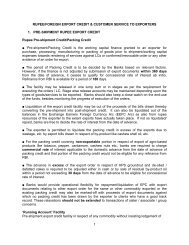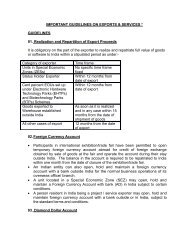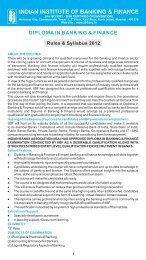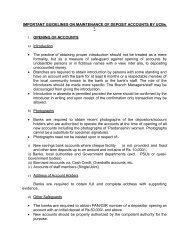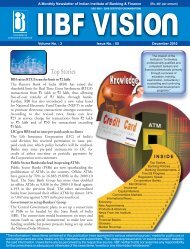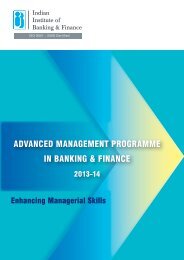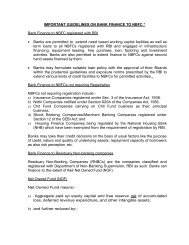Keb[ / DebkeÀ / pegueeF& - efmelebyej /
special feature - Indian Institute of Banking & Finance
special feature - Indian Institute of Banking & Finance
- No tags were found...
Create successful ePaper yourself
Turn your PDF publications into a flip-book with our unique Google optimized e-Paper software.
editorialevident that reforms have definitely made the bank managements and Boards more responsiblethan the pre-reform era when the banks had almost nothing much to manage!A mile stone in the deregulation / re-regulation is the introduction of Capital Adequacy normsand the Income Recognition and Asset Classification norms. The introduction of these norms,albeit in a phased manner, showed that the net worth of the banks stands eroded and theGovernment had to recapitalize the banks. These norms made the banks look afresh into the wayof doing business. Even as the banks grapple with the issue of credit risk and move towards bettercredit management, waiver, CDR and interest subventions tend to impact the efficacy of ALMand Loan policies.A related issue is the risk management and introduction of Basel norms. PSBs are highlyconstrained in this because of the 51% GOI ownership. This warranted innovations by RBI indeveloping new capital instruments. Globalization and adoption of technology has brought abouta renewed sense of risk and security which were hitherto of lesser importance. KYC is a key concern.The need for elaborate AML procedures and increased focus on IT Security has also changed theway banks do business. Going forward the issue will be the inclusion agenda. Given the vastness ofthe issue, past experiences in the case of IRDP, this may not be an easy agenda to complete.Today, the private banks, foreign banks and PSBs target the same audience - the burgeoningmiddle class- and retail banking. It appears that the typical 'private banking' (which ispracticed in the West and which was one of the main causes for the financial crisis) focused onHNI may not happen in a big way, though some of the private banks have started special fundsand many new private fund houses are being set up. As such, it seems all banks will tend to dosimilar things in future. Further it appears that the DSA / DMA model may not come back inthe near future. Branch banking with technology seems to be the current driver and will be theway forward. It is in this background that PSU banks have opted for massive recruitment.In view of the above, what were the drivers of transformation? Does the fact that the performanceof PSBs is somewhat similar; is the transformation of PSBs a function of policy changes? It seemsthe answer is that the PSBs are transforming without any major internal push or drive. Yet, interms of inter se ranking, if there was one, some of them have done better than the past.Indian bank is a case in the point. This bank was facing a crisis of sorts not only due to reasonsmentioned above but also on account of a high level of NPA. Employee morale was low. Thetransformation story ("A New Beginning"- Ranjana Kumar) clearly shows the importance ofHR strategies and leadership in achieving the turn around.In the case of SBI, the first stimulus was the introduction of core banking solutions (Case studyby TCS -The Tower Group). SBI accounts for not only a fourth of business in the country butit also employs a share more than a fourth of the work force of banking industry. It was losingmarket share and toying with the idea of consolidating the group. The well documentedThe Journal of Indian Institute of Banking & Finance July - September 2011 5



